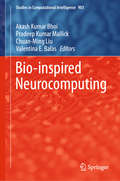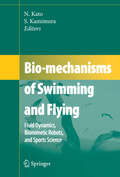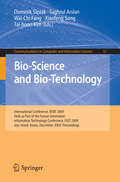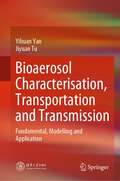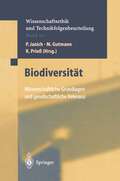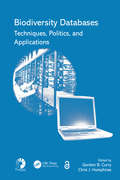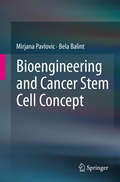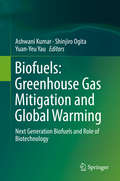- Table View
- List View
Bio-Inspired Models of Network, Information, and Computing Systems: 5th International ICST Conference, BIONETICS 2010, Boston (Lecture Notes of the Institute for Computer Sciences, Social Informatics and Telecommunications Engineering #87)
by Junichi Suzuki Tadashi NakanoThis book constitutes the thoroughly refereed post-conference proceedings of the 5th International ICST Conference on Bio-Inspired Models of Network, Information, and Computing Systems (BIONETICS 2010) which was held in Boston, USA, in December 2010. The 78 revised full papers were carefully reviewed and selected from numerous submissions for inclusion in the proceedings. BIONETICS 2010 aimed to provide the understanding of the fundamental principles and design strategies in biological systems and leverage those understandings to build bio-inspired systems.
Bio-inspired Networking
by Daniel CâmaraBio-inspired techniques are based on principles, or models, of biological systems. In general, natural systems present remarkable capabilities of resilience and adaptability. In this book, we explore how bio-inspired methods can solve different problems linked to computer networks.Future networks are expected to be autonomous, scalable and adaptive. During millions of years of evolution, nature has developed a number of different systems that present these and other characteristics required for the next generation networks. Indeed, a series of bio-inspired methods have been successfully used to solve the most diverse problems linked to computer networks. This book presents some of these techniques from a theoretical and practical point of view.Discusses the key concepts of bio-inspired networking to aid you in finding efficient networking solutionsDelivers examples of techniques both in theoretical concepts and practical applicationsHelps you apply nature's dynamic resource and task management to your computer networks
Bio-inspired Neurocomputing (Studies in Computational Intelligence #903)
by Akash Kumar Bhoi Pradeep Kumar Mallick Chuan-Ming Liu Valentina E. BalasThis book covers the latest technological advances in neuro-computational intelligence in biological processes where the primary focus is on biologically inspired neuro-computational techniques. The theoretical and practical aspects of biomedical neural computing, brain-inspired computing, bio-computational models, artificial intelligence (AI) and machine learning (ML) approaches in biomedical data analytics are covered along with their qualitative and quantitative features. The contents cover numerous computational applications, methodologies and emerging challenges in the field of bio-soft computing and bio-signal processing. The authors have taken meticulous care in describing the fundamental concepts, identifying the research gap and highlighting the problems with the strategical computational approaches to address the ongoing challenges in bio-inspired models and algorithms. Given the range of topics covered, this book can be a valuable resource for students, researchers as well as practitioners interested in the rapidly evolving field of neurocomputing and biomedical data analytics.
Bio-Inspired Optimization for Medical Data Mining
by Abhishek Kumar Sumit Srivastava Pramod Singh Rathore Abhineet Anand Bhavna SainiThis book is a comprehensive exploration of bio-inspired optimization techniques and their potential applications in healthcare. Bio-Inspired Optimization for Medical Data Mining is a groundbreaking book that delves into the convergence of nature’s ingenious algorithms and cutting-edge healthcare technology. Through a comprehensive exploration of state-of-the-art algorithms and practical case studies, readers gain unparalleled insights into optimizing medical data processing, enabling more precise diagnosis, optimizing treatment plans, and ultimately advancing the field of healthcare. Organized into 15 chapters, readers learn about the theoretical foundation of pragmatic implementation strategies and actionable advice. In addition, it addresses current developments in molecular subtyping and how they can enhance clinical care. By bridging the gap between cutting-edge technology and critical healthcare challenges, this book is a pivotal contribution, providing a roadmap for leveraging nature-inspired algorithms. In this book, the reader will discover Cutting-edge bio-inspired algorithms designed to optimize medical data processing, providing efficient and accurate solutions for complex healthcare challenges; How bio-inspired optimization can fine-tune diagnostic accuracy, leading to better patient outcomes and improved medical decision-making; How bio-inspired optimization propels healthcare into a new era, unlocking transformative solutions for medical data analysis; Practical insights and actionable advice on implementing bio-inspired optimization techniques and equipping effective real-world medical data scenarios; Compelling case studies illustrating how bio-inspired optimization has made a significant impact in the medical field, inspiring similar success stories. Audience This book is designed for a wide-ranging audience, including medical professionals, healthcare researchers, data scientists, and technology enthusiasts.
Bio-Inspired Optimization for Medical Data Mining
by Abhishek Kumar Sumit Srivastava Pramod Singh Rathore Abhineet Anand Bhawna SainiThis book is a comprehensive exploration of bio-inspired optimization techniques and their potential applications in healthcare. Bio-Inspired Optimization for Medical Data Mining is a groundbreaking book that delves into the convergence of nature’s ingenious algorithms and cutting-edge healthcare technology. Through a comprehensive exploration of state-of-the-art algorithms and practical case studies, readers gain unparalleled insights into optimizing medical data processing, enabling more precise diagnosis, optimizing treatment plans, and ultimately advancing the field of healthcare. Organized into 15 chapters, readers learn about the theoretical foundation of pragmatic implementation strategies and actionable advice. In addition, it addresses current developments in molecular subtyping and how they can enhance clinical care. By bridging the gap between cutting-edge technology and critical healthcare challenges, this book is a pivotal contribution, providing a roadmap for leveraging nature-inspired algorithms. In this book, the reader will discover Cutting-edge bio-inspired algorithms designed to optimize medical data processing, providing efficient and accurate solutions for complex healthcare challenges; How bio-inspired optimization can fine-tune diagnostic accuracy, leading to better patient outcomes and improved medical decision-making; How bio-inspired optimization propels healthcare into a new era, unlocking transformative solutions for medical data analysis; Practical insights and actionable advice on implementing bio-inspired optimization techniques and equipping effective real-world medical data scenarios; Compelling case studies illustrating how bio-inspired optimization has made a significant impact in the medical field, inspiring similar success stories. Audience This book is designed for a wide-ranging audience, including medical professionals, healthcare researchers, data scientists, and technology enthusiasts.
Bio-Inspired Optimization in Fog and Edge Computing Environments: Principles, Algorithms, and Systems
by Punit Gupta Dinesh Kumar Saini Pradeep Singh Rawat Kashif ZiaA new era of complexity science is emerging, in which nature- and bio-inspired principles are being applied to provide solutions. At the same time, the complexity of systems is increasing due to such models like the Internet of Things (IoT) and fog computing. Will complexity science, applying the principles of nature, be able to tackle the challenges posed by highly complex networked systems? Bio-Inspired Optimization in Fog and Edge Computing: Principles, Algorithms, and Systems is an attempt to answer this question. It presents innovative, bio-inspired solutions for fog and edge computing and highlights the role of machine learning and informatics. Nature- or biological-inspired techniques are successful tools to understand and analyze a collective behavior. As this book demonstrates, algorithms, and mechanisms of self-organization of complex natural systems have been used to solve optimization problems, particularly in complex systems that are adaptive, ever-evolving, and distributed in nature. The chapters look at ways of enhancingto enhance the performance of fog networks in real-world applications using nature-based optimization techniques. They discuss challenges and provide solutions to the concerns of security, privacy, and power consumption in cloud data center nodes and fog computing networks. The book also examines how: The existing fog and edge architecture is used to provide solutions to future challenges. A geographical information system (GIS) can be used with fog computing to help users in an urban region access prime healthcare. An optimization framework helps in cloud resource management. Fog computing can improve the quality, quantity, long-term viability, and cost-effectiveness in agricultural production. Virtualization can support fog computing, increase resources to be allocated, and be applied to different network layers. The combination of fog computing and IoT or cloud computing can help healthcare workers predict and analyze diseases in patients.
Bio-Inspired Optimization in Fog and Edge Computing Environments: Principles, Algorithms, and Systems
by Punit Gupta Dinesh Kumar Saini Pradeep Rawat Kashif ZiaA new era of complexity science is emerging, in which nature- and bio-inspired principles are being applied to provide solutions. At the same time, the complexity of systems is increasing due to such models like the Internet of Things (IoT) and fog computing. Will complexity science, applying the principles of nature, be able to tackle the challenges posed by highly complex networked systems? Bio-Inspired Optimization in Fog and Edge Computing: Principles, Algorithms, and Systems is an attempt to answer this question. It presents innovative, bio-inspired solutions for fog and edge computing and highlights the role of machine learning and informatics. Nature- or biological-inspired techniques are successful tools to understand and analyze a collective behavior. As this book demonstrates, algorithms, and mechanisms of self-organization of complex natural systems have been used to solve optimization problems, particularly in complex systems that are adaptive, ever-evolving, and distributed in nature. The chapters look at ways of enhancingto enhance the performance of fog networks in real-world applications using nature-based optimization techniques. They discuss challenges and provide solutions to the concerns of security, privacy, and power consumption in cloud data center nodes and fog computing networks. The book also examines how: The existing fog and edge architecture is used to provide solutions to future challenges. A geographical information system (GIS) can be used with fog computing to help users in an urban region access prime healthcare. An optimization framework helps in cloud resource management. Fog computing can improve the quality, quantity, long-term viability, and cost-effectiveness in agricultural production. Virtualization can support fog computing, increase resources to be allocated, and be applied to different network layers. The combination of fog computing and IoT or cloud computing can help healthcare workers predict and analyze diseases in patients.
Bio-Inspired Self-Organizing Robotic Systems (Studies in Computational Intelligence #355)
by Yan Meng Yaochu JinSelf-organizing approaches inspired from biological systems, such as social insects, genetic, molecular and cellular systems under morphogenesis, and human mental development, has enjoyed great success in advanced robotic systems that need to work in dynamic and changing environments. Compared with classical control methods for robotic systems, the major advantages of bio-inspired self-organizing robotic systems include robustness, self-repair and self-healing in the presence of system failures and/or malfunctions, high adaptability to environmental changes, and autonomous self-organization and self-reconfiguration without a centralized control. “Bio-inspired Self-organizing Robotic Systems” provides a valuable reference for scientists, practitioners and research students working on developing control algorithms for self-organizing engineered collective systems, such as swarm robotic systems, self-reconfigurable modular robots, smart material based robotic devices, unmanned aerial vehicles, and satellite constellations.
Bio-Inspired Systems: 10th International Work-Conference on Artificial Neural Networks, IWANN 2009, Salamanca, Spain, June 10-12, 2009. Proceedings, Part I (Lecture Notes in Computer Science #5517)
by Joan Cabestany Francisco Sandoval Alberto Prieto Juan Manuel Corchado RodríguezThis volume presents the set of final accepted papers for the tenth edition of the IWANN conference “International Work-Conference on Artificial neural Networks” held in Salamanca (Spain) during June 10–12, 2009. IWANN is a biennial conference focusing on the foundations, theory, models and applications of systems inspired by nature (mainly, neural networks, evolutionary and soft-computing systems). Since the first edition in Granada (LNCS 540, 1991), the conference has evolved and matured. The list of topics in the successive Call for - pers has also evolved, resulting in the following list for the present edition: 1. Mathematical and theoretical methods in computational intelligence. C- plex and social systems. Evolutionary and genetic algorithms. Fuzzy logic. Mathematics for neural networks. RBF structures. Self-organizing networks and methods. Support vector machines. 2. Neurocomputational formulations. Single-neuron modelling. Perceptual m- elling. System-level neural modelling. Spiking neurons. Models of biological learning. 3. Learning and adaptation. Adaptive systems. Imitation learning. Reconfig- able systems. Supervised, non-supervised, reinforcement and statistical al- rithms. 4. Emulation of cognitive functions. Decision making. Multi-agent systems. S- sor mesh. Natural language. Pattern recognition. Perceptual and motor functions (visual, auditory, tactile, virtual reality, etc.). Robotics. Planning motor control. 5. Bio-inspired systems and neuro-engineering. Embedded intelligent systems. Evolvable computing. Evolving hardware. Microelectronics for neural, fuzzy and bio-inspired systems. Neural prostheses. Retinomorphic systems. Bra- computer interfaces (BCI). Nanosystems. Nanocognitive systems.
Bio-inspired Systems and Applications: 9th International Work-Conference on the Interplay Between Natural and Artificial Computation, IWINAC 2022, Puerto de la Cruz, Tenerife, Spain, May 31 – June 3, 2022, Proceedings, Part II (Lecture Notes in Computer Science #13259)
by José Manuel Ferrández Vicente José Ramón Álvarez-Sánchez Félix de la Paz López Hojjat AdeliThe two volume set LNCS 13258 and 13259 constitutes the proceedings of the International Work-Conference on the Interplay Between Natural and Artificial Computation, IWINAC 2022, held in Puerto de la Cruz, Tenerife, Spain in May – June 2022. The total of 121 contributions was carefully reviewed and selected from 203 submissions. The papers are organized in two volumes, with the following topical sub-headings: Part I: Machine Learning in Neuroscience; Neuromotor and Cognitive Disorders; Affective Analysis; Health Applications Part II: Affective Computing in Ambient Intelligence; Bioinspired Computing Approaches; Machine Learning in Computer Vision and Robot; Deep Learning; Artificial Intelligence Applications.
Bio-Inspired Technologies for the Hardware of Adaptive Systems: Real-World Implementations and Applications (Studies in Computational Intelligence #179)
by Mircea Gh. Negoita Sorin HinteaEvolvable Hardware (EHW) has emerged as a sub-domain of artificial evolution represented by a design methodology (consortium of methods) involving the application of Evolutionary Algorithms (EA) to the synthesis of digital and analogue electronic circuits and systems. Nevertheless, the most benefit for the society and indeed most revolutionizing application of EA is its hardware implementation leading to the EHW. These new EA based methodologies led to a new type of machines that is evolved to attain a desired behaviour, which means they have a behavioural computational intelligence. EHW is a special case of the adaptive hardware, namely being strongly related to the Adaptive Systems (AS) and the Adaptive Hardware (AH). The book presents a careful selection of the field that very well reflects the breadth of this high technology and its terminology and applications in context of the AS/AH. The harmonious symbiosis of the engineering approach and the accurate scientific methodology features the aspects of highly relevant and practical design principles governing the development of EHW and its connections with AS/AH. This book is both attractive and useful for everybody interested in the design and analysis of EHW in context of AS/AH and implementation of real time adaptive hardware hybrid intelligent systems.
Bio-inspiring Cyber Security and Cloud Services: Trends And Innovations (Intelligent Systems Reference Library #70)
by Aboul Ella Hassanien Tai-Hoon Kim Janusz Kacprzyk Ali Ismail AwadThis volume presents recent research in cyber security and reports how organizations can gain competitive advantages by applying the different security techniques in real-world scenarios. The volume provides reviews of cutting–edge technologies, algorithms, applications and insights for bio-inspiring cyber security-based systems. The book will be a valuable companion and comprehensive reference for both postgraduate and senior undergraduate students who are taking a course in cyber security. The volume is organized in self-contained chapters to provide greatest reading flexibility.
Bio-mechanisms of Swimming and Flying: Fluid Dynamics, Biomimetic Robots, and Sports Science
by Naomi Kato Shinji KamimuraThis book covers a wide range of animals from flagellated microorganisms to marine mammals. It follows "Bio-mechanisms of Animals in Swimming and Flying" published in 2004 including 11 chapters. This time, the book includes 31 chapters on the latest researches into natural autonomous systems and locomotion in both flying and swimming organisms. The area of sports science such as analysis and simulation of human swimming is newly added. The computational frameworks for the modeling, simulation and optimization of animals in swimming and flying demonstrate an important role in the progress of interdisciplinary work in the fields of biology and engineering.
Bio-Science and Bio-Technology: International Conference, BSBT 2009 Held as Part of the Future Generation Information Technology Conference, FGIT 2009 Jeju Island, Korea, December 10-12, 2009 Proceedings (Communications in Computer and Information Science #57)
by Dominik 346 L 281 Zak Tughrul Arslan Xiaofeng Song Tai-Hoon KimAs future generation information technology (FGIT) becomes specialized and fr- mented, it is easy to lose sight that many topics in FGIT have common threads and, because of this, advances in one discipline may be transmitted to others. Presentation of recent results obtained in different disciplines encourages this interchange for the advancement of FGIT as a whole. Of particular interest are hybrid solutions that c- bine ideas taken from multiple disciplines in order to achieve something more signi- cant than the sum of the individual parts. Through such hybrid philosophy, a new principle can be discovered, which has the propensity to propagate throughout mul- faceted disciplines. FGIT 2009 was the first mega-conference that attempted to follow the above idea of hybridization in FGIT in a form of multiple events related to particular disciplines of IT, conducted by separate scientific committees, but coordinated in order to expose the most important contributions. It included the following international conferences: Advanced Software Engineering and Its Applications (ASEA), Bio-Science and Bio-Technology (BSBT), Control and Automation (CA), Database Theory and Application (DTA), D- aster Recovery and Business Continuity (DRBC; published independently), Future G- eration Communication and Networking (FGCN) that was combined with Advanced Communication and Networking (ACN), Grid and Distributed Computing (GDC), M- timedia, Computer Graphics and Broadcasting (MulGraB), Security Technology (SecTech), Signal Processing, Image Processing and Pattern Recognition (SIP), and- and e-Service, Science and Technology (UNESST).
Bioaerosol Characterisation, Transportation and Transmission: Fundamental, Modelling and Application
by Yihuan Yan Jiyuan TuThis book aims to predict and model the transport of bioaerosols, identify their transmission characteristics, and assess occupants’ infection risks. Although existing epidemiological books provide fundamental infection rate of existing diseases, the ability of predicting emerging disease transmission in the air and assessing occupants’ infection risks to the bioaerosols is significantly lacking. This book is considered as a professional book that provides in-depth discussion of the aforementioned issues and provides potential approaches to solve these issues would be highly demanded by readers in this emerging research field. This book offers essential and systematic analysis on the fate of bioaerosols from their release in the air to the final destination in human’s respiratory systems through direct 3D visualizations techniques. It also provides quantifiable method to assess each occupant’s infection risks to the infectious bioaerosols in indoor environments. The readers will gain essential fundamental characteristics of bioaerosols (active time, viability, etc.) and will gain the advanced skills on how to integrate these properties into numerical modeling and assess the occupants’ exposure risks.
Biobazaar: The Open Source Revolution and Biotechnology
by Janet HopeFighting disease, combating hunger, preserving the balance of life on Earth: the future of biotechnological innovation may well be the future of our planet itself. And yet the vexed state of intellectual property law—a proliferation of ever more complex rights governing research and development—is complicating this future. At a similar point in the development of information technology, “open source” software revolutionized the field, simultaneously encouraging innovation and transforming markets. The question that Janet Hope explores in Biobazaar is: can the open source approach do for biotechnology what it has done for information technology? Her book is the first sustained and systematic inquiry into the application of open source principles to the life sciences. The appeal of the open source approach—famously likened to a “bazaar,” in contrast to the more traditional “cathedral” style of technology development—lies in its safeguarding of community access to proprietary tools without discouraging valuable commercial participation. Traversing disciplinary boundaries, Hope presents a careful analysis of intellectual property-related challenges confronting the biotechnology industry and then paints a detailed picture of “open source biotechnology” as a possible solution. With insights drawn from interviews with Nobel Prize–winning scientists and leaders of the free and open source software movement—as well as company executives, international policymakers, licensing experts, and industry analysts—her book suggests that open source biotechnology is both desirable and broadly feasible—and, in many ways, merely awaiting its moment.
Biocomputing (Biocomputing #1)
by Panos M. Pardalos J. C. PrincipeIn the quest to understand and model the healthy or sick human body, re searchers and medical doctors are utilizing more and more quantitative tools and techniques. This trend is pushing the envelope of a new field we call Biomedical Computing, as an exciting frontier among signal processing, pattern recognition, optimization, nonlinear dynamics, computer science and biology, chemistry and medicine. A conference on Biocomputing was held during February 25-27, 2001 at the University of Florida. The conference was sponsored by the Center for Applied Optimization, the Computational Neuroengineering Center, the Biomedical En gineering Program (through a Whitaker Foundation grant), the Brain Institute, the School of Engineering, and the University of Florida Research & Graduate Programs. The conference provided a forum for researchers to discuss and present new directions in Biocomputing. The well-attended three days event was highlighted by the presence of top researchers in the field who presented their work in Biocomputing. This volume contains a selective collection of ref ereed papers based on talks presented at this conference. You will find seminal contributions in genomics, global optimization, computational neuroscience, FMRI, brain dynamics, epileptic seizure prediction and cancer diagnostics. We would like to take the opportunity to thank the sponsors, the authors of the papers, the anonymous referees, and Kluwer Academic Publishers for making the conference successful and the publication of this volume possible. Panos M. Pardalos and Jose C.
Bioconductor Case Studies (Use R!)
by Florian Hahne Wolfgang Huber Robert Gentleman Seth FalconBioconductor software has become a standard tool for the analysis and comprehension of data from high-throughput genomics experiments. Its application spans a broad field of technologies used in contemporary molecular biology. In this volume, the authors present a collection of cases to apply Bioconductor tools in the analysis of microarray gene expression data. Topics covered include: (1) import and preprocessing of data from various sources; (2) statistical modeling of differential gene expression; (3) biological metadata; (4) application of graphs and graph rendering; (5) machine learning for clustering and classification problems; (6) gene set enrichment analysis. Each chapter of this book describes an analysis of real data using hands-on example driven approaches. Short exercises help in the learning process and invite more advanced considerations of key topics. The book is a dynamic document. All the code shown can be executed on a local computer, and readers are able to reproduce every computation, figure, and table.
Biodental Engineering II
by R. M. Natal Jorge J. C. Reis Campos Sónia M. Santos Joao Manuel R. S. TavaresDentistry is a branch of medicine with its own peculiarities and very diverse areas of action, which means that it can be considered as an interdisciplinary field. BIODENTAL ENGINEERING II contains the full papers presented at the 2nd International Conference on Biodental Engineering (BioDENTAL 2012, Porto, Portugal, 7-8 December 2012). The contrib
Biodiversität: Wissenschaftliche Grundlagen und gesetzliche Relevanz (Ethics of Science and Technology Assessment #10)
by F. WütscherDie interdisziplinär besetzte Projektgruppe Biodiversität der Europäischen Akademie Bad Neuenahr-Ahrweiler hat sich die Aufgabe gestellt, den wissenschaftlichen Sachstand aus den verschiedenen Disziplinen zusammenzutragen und die diversen, auf der Grundlage fachspezifischer Methoden entwickelten Konzepte gemeinsam zu untersuchen.In den in diesem Band versammelten Ergebnissen finden sich entsprechend neben den rein naturwissenschaftlichen auch relevante erkenntnis- und wissenschaftstheoretische Fragen sowie juristische und ökonomische Aspekte diskutiert. Damit bietet das Buch einen guten Überblick über den Diskussionsstand und eine solide Grundlage für die weitere wissenschaftliche Diskussion.
Biodiversity Databases: Techniques, Politics, and Applications
by Gordon B. CurryWith changes in technology and a renewed effort to catalog the world's biodiversity, huge amounts of data are being generated on biodiversity issues. As response to the call for better information systems to manage the biodiversity crisis, a wide range of solutions are being developed for inventorying, managing, and disseminating taxonomic data. This book brings together a diverse array of authors, expertise, and assessors that discuss technical developments to improve the construction, population, and dissemination of biodiversity information. It is designed to inform students and researchers of biodiversity about the changes and challenges that need to be understood by everyone in this information age.
Biodiversity Databases: Techniques, Politics, and Applications
by Gordon B. Curry Chris J. HumphriesWith changes in technology and a renewed effort to catalog the world's biodiversity, huge amounts of data are being generated on biodiversity issues. As response to the call for better information systems to manage the biodiversity crisis, a wide range of solutions are being developed for inventorying, managing, and disseminating taxonomic data. This book brings together a diverse array of authors, expertise, and assessors that discuss technical developments to improve the construction, population, and dissemination of biodiversity information. It is designed to inform students and researchers of biodiversity about the changes and challenges that need to be understood by everyone in this information age.
Bioengineering and Biomedical Signal and Image Processing: First International Conference, BIOMESIP 2021, Meloneras, Gran Canaria, Spain, July 19-21, 2021, Proceedings (Lecture Notes in Computer Science #12940)
by Ignacio Rojas Daniel Castillo-Secilla Luis Javier Herrera Héctor PomaresThis book constitutes the refereed proceedings of the First International Conference on Bioengineering and Biomedical Signal and Image Processing, BIOMESIP 2021, held in Meloneras, Gran Canaria, Spain, in July 2021. The 41 full and 5 short papers were carefully reviewed and selected from 121 submissions. The papers are grouped in topical issues on biomedical applications in molecular, structural, and functional imaging; biomedical computing; biomedical signal measurement, acquisition and processing; computerized medical imaging and graphics; disease control and diagnosis; neuroimaging; pattern recognition and machine learning for biosignal data; personalized medicine; and COVID-19.
Bioengineering and Cancer Stem Cell Concept (SpringerBriefs in Computer Science #0)
by Mirjana Pavlovic Bela BalintThis book explores the role of cancer stem cells in the diagnosis, treatment, and cure of cancers. This book also tackles novel methodology for cancer stem cell marker identification, cancer stem cell respiration and metabolism, genetic and epigenetic mechanisms including DNA methylation, and mi-RNA assemble. It also emphasizes the role of Bioinformatics techniques, which provide a novel methodology for modeling cancer outcomes. The authors investigate the difference between cancer stem cells and normal stem cells, along with the concept of targeted cancer stem cell therapy. Although the theoretical explanations of cancer stem cell involvement in leukemia and solid cancers are controversial, there is now little doubt that cancer stem cells exist within otherwise heterogeneous cancer cell population. The brief examines the two leading theories, hierarchical and the stochastic/cancer stem cell model. Researchers, professors and advanced-level students focused on bioengineering and computer science will find this book to be a valuable resource. It is a very good source of critical references for understanding of this problem, and a useful tool for professionals in related fields.
Biofuels: Next Generation Biofuels and Role of Biotechnology
by Ashwani Kumar Shinjiro Ogita Yuan-Yeu YauThis timely book is a compilation of edited articles by distinguished international scientists discussing global warming, its causes as well as present and future solutions. Social and economic growth at global level is measured in terms of GDP, which requires energy inputs generally based on fossil fuel resources. These, however, are major contributors to increasing levels of CO2, causing 15 tonnes of green house gas emissions per capita. Renewable sources of energy offer an alternative to fossil fuels, and would help reduce this to the 2 tonnes of greenhouse gas emissions per capita per annum needed to achieve sustainable growth. As such, the book discusses the next-generation of biofuels and all related aspects, based on the editors’ significant investigations on biofuels over the last 30 years. It also presents the latest research findings from research work carried out by contemporary researchers. Presenting global biofuel perspectives, it examines various issues related to sustainable development of biofuels in the contexts of agriculture, forestry, industry and economic growth. It covers the 1st to 4th generation biofuels, as well as the status of biofuel resources and their potential in carbon neutral economy. Offering a comprehensive, state-of-art overview of current and future biofuels at local and global levels, this book appeals to administrators, policy makers, universities and research institutions.


